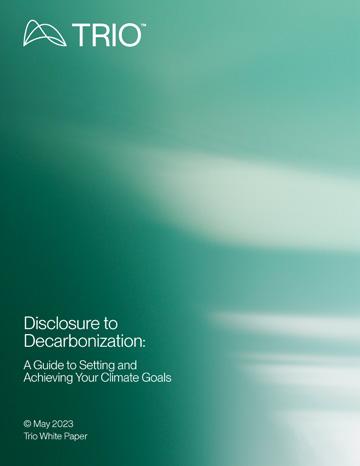
Introduction
A Framework for Supplier Engagement
8
Data: A Roadmap for Complex Challenges 11 Education and Engagement: Aligning Aspirations
6 Strategy: Setting the Foundation for Succes
12 Implementation: Driving Impact Together


Introduction
A Framework for Supplier Engagement
8
Data: A Roadmap for Complex Challenges 11 Education and Engagement: Aligning Aspirations
6 Strategy: Setting the Foundation for Succes
12 Implementation: Driving Impact Together
As the business sector gains a more sophisticated level of understanding around climate-related risks and opportunities, there has been an increased recognition that sustainability efforts must extend beyond a company’s direct operations. Disruptions caused by climate impacts have exposed the vulnerability of supply chains, along with the growing concern that critical suppliers may not be adequately prepared for the clean energy transition. As a result, more companies recognize the urgent business imperative to engage and partner with suppliers to address carbon emissions across their entire value chains.
Addressing these emissions is essential to achieving corporate sustainability goals and increasing supply chain continuity. For most companies, emissions from the supply chain are significantly larger than those from their own operations. In fact, a recent CDP study shows that companies’ supply chain emissions are approximately 11.4 times higher than the emissions from their direct operations
With the growing recognition of the scale of supply chain emissions in greenhouse gas (GHG) inventories, measuring and
addressing those emissions is quickly becoming an expectation for supply chain owners . Widely accepted standards, like the Science Based Targets initiative (SBTi), as well as government regulations such as Europe’s Corporate Sustainability Reporting Directive (CSRD) and California’s recently passed Climate Corporate Data Accountability Act (CCDAA) , include supply chain emissions as well as operational emissions.
While addressing emissions that are beyond your company’s direct control can seem daunting, “going to where the emissions are” is key to driving sustainability impact and meeting stakeholder expectations and can produce tangible benefits for your business.
In addition to reducing global emissions, addressing supply chain emissions can strengthen relationships with suppliers and customers and identify ways you can collaborate to reduce costs. It can also serve as a catalyst for reimagining products and processes while showing investors and other stakeholders that your company is prepared to manage the challenges and seize the opportunities inherent in decarbonization.

For supply chain owners with complex global supply chains, addressing supply chain emissions can seem challenging due to:
• The sheer number of suppliers and the typically global and complex nature of supply chains
• Limited supply chain visibility and transparency
• Varying levels of expertise, sustainability maturity, commitment, and willingness from suppliers to engage on sustainability topics
• Incomplete, inconsistent, or unreliable emissions data from suppliers
• Perception of supply chain owner’s competing priorities (affordability, business continuity, sustainability) and the depth and durability of their commitment to sustainability, especially when achieving those commitments means new investments or higher costs
Taking a strategic, systematic approach to supplier engagement can help you break down the complex challenges of supply chain engagement into manageable steps and practical initiatives that drive impact.
Because each supply chain is unique, supply chain engagement programs should be customized to meet the needs of both supply chain owners and the diverse range of suppliers that make up their value chains. With that said, we have found that the most successful approaches are based on three pillars: data, education and engagement, and implementation.
But a successful program takes more than a smart strategy. The most successful supply chain emissions reduction programs are those that are designed to foster collaboration between suppliers and supply chain owners. Open and ongoing communication with suppliers around their needs, challenges, and wins – and transparently incorporating feedback from suppliers into your strategies and approaches as the program progresses - is essential to facilitating the trust, mutual collaboration, and shared ownership that will ultimately deliver success.
Developing a clear strategy is critical to the success of a supplier decarbonization program, starting with the establishment of credible and ambitious emissions reduction targets that cover scopes 1, 2 and 3, and demonstrating sustainability leadership by managing emissions within your own operations. Making progress towards your own sustainability goals allows you to develop practical expertise you can use to support and collaborate with your supply chain partners along their journey. By articulating your ambition across scopes 1, 2 and 3, you can demonstrate to your suppliers that you are aligning your commitment with theirs and that you will be a credible partner in achieving decarbonization.
Once you have established clear goals, the next step is to think through how best to design and stage a program to engage and partner with your suppliers. While achieving scope 3 goals can feel insurmountable, much can be accomplished by breaking the work into manageable parts.
Setting clear boundaries and priorities will help focus your efforts where they will have the greatest impact. Aspects to consider include key industries and spend types that are driving your emissions, regional prioritization, your relationships with your suppliers, and the maturity of their decarbonization programs. Once you have a strategy in place, you can develop a customized

engagement program for each group that considers the three pillars:
• Data: Metrics and key performance indicators required to inform strategy, and track and monitor progress
• Education & Engagement: Training and resources customized to supplier maturity to support your goals
• Implementation: Solutions to help scale decarbonization across your supply chain
Before you set the plan in motion and begin engaging suppliers, make sure you are fully aligned internally on your approach. Sustainability can sometimes mean changes to procurement processes and even additional investments, so it is important to decide in advance if you intend to mandate performance improvements from suppliers or incentivize them.
By thoughtfully considering your approach to requirements and incentives in advance, you can design a program that best fosters the productive collaboration necessary to ensure your suppliers have the knowledge and resources they need to join you on your sustainability journey.

the Whitepaper

Transform: Auto is a program aimed at driving the adoption of renewable energy across the automotive supply chain. Direct (Tier 1) suppliers to program sponsors Ford Motor Company, General Motors, Honda, Magna, Toyota and Cummins, and members of the Suppliers Partnership for the Environment, are eligible to participate for free. The program is facilitated by the renewable energy and sustainability experts at Trio.
Read more about Transform: Auto →
Data can serve as your roadmap, allowing you to identify and prioritize suppliers who are responsible for the most emissions so that you can focus your time and resources where they will have the greatest impact. However, for many companies with large, complex supply chains, the sheer number of suppliers to engage can be a barrier to action . Most companies do not have access to complete and accurate emissions data across their entire supply chain.
But even if you start with imperfect data, it is important to start somewhere. In many cases, simply focusing on the top 80% of spend can help companies identify the suppliers that contribute the most to their carbon emissions. Typically, 20% of suppliers account for 80% of spend, so this prioritization can be a smart and efficient way of getting started.
As you gather more data and improve your data collection methods, you will be able to refine your understanding of your supply chain emissions. This will allow you to make more informed and focused decisions about how to achieve your goals.
By taking an iterative approach to supply chain emissions data, companies can work to address the uncertainties inherent to supply chain emissions without allowing that uncertainty to impede progress or delay impact. Ultimately, decarbonization - not data - is the real north star. And while data is essential to demystifying complex supply chains and informing strategy, launching supplier engagement programs, fostering collaboration and relationships, building trust, and making progress towards your decarbonization goals is just as important – and doesn’t need to wait for perfect data.
Companies that take this approach begin by gathering available supplier emissions data, then filling in gaps with estimates based on spend, industry averages, and other proxy data. This allows them to start with a credible snapshot of their supply chain emissions that can help shape a broad strategy and get to work.
As suppliers become more educated and engaged in this work, their ability and willingness to share quality data improves, providing supply chain owners with a more accurate and granular view of their supply chain emissions and allowing them to adjust strategies, priorities, and programs as needed.

Trio recently sat down with the Sustainable Procurement team at Bristol Myers Squibb (BMS) to discuss their joint partnership in launching the Supplier Decarbonization Accelerator, which provides complimentary resources and support to key suppliers who are being asked by BMS to set sciencebased targets by 2028.
The program is focused on supplier engagement and education designed to inform suppliers on BMS’s climate goals and provide tailored resources to support suppliers wherever they are on their sustainability journey.
Read more →
“Meeting our emissions reduction targets requires innovation and partnership. Helping to build the capabilities of our suppliers is a critical component of this.”
Following a Trio training series on decarbonization strategy, 85% of participating suppliers shared that they planned to take action
Supply chains are global and complex, and your suppliers are likely to come to this work with different levels of understanding and capability when it comes to sustainability. It is important to assess and categorize the needs of your suppliers to ensure that your program is of value -- no matter where they are on their sustainability journey. A successful supplier engagement program should be accessible and empowering, and customized to meet the needs of suppliers with varying levels of understanding and maturity on this topic. It should also:
• Adhere to best practices including the Greenhouse Gas Protocol and SBTi
• Support change and progress
• Align with expectations of other supply chain owners in your industry
• Drive disclosure with impact

While procurement teams typically have strong relationships with suppliers and deep experience developing procurement strategies, they sometimes lack the sustainability expertise and resources necessary to develop and manage this type of robust supplier education program.
Furthermore, many suppliers will need one-on-one support to understand what you are asking of them and why it is important, and to overcome challenges specific to their operations and local market conditions. Many procurement teams simply lack the bandwidth to provide that kind of individualized engagement.
Bringing in outside resources to develop tailored supplier education programs, and providing one-on-one coaching and support, can take the burden off your procurement team, prevent delays, and provide them with the confidence that they have the tools they need to deliver the support suppliers will need to join you on your sustainability journey.

Supply chain owners will find that suppliers are at various levels of readiness to take on emissions reduction projects.
One defining factor is for the supplier to have management signoff on a carbon reduction goal. Suppliers who meet this threshold are the best candidates to take on projects that will generate meaningful emissions reductions. While it is possible to aggregate supplier efforts at emissions reductions, suppliers are likely to launch this work with varying levels of commitment, expertise, and experience, with each supplier likely requiring some level of individualized support.
Supplier criteria such as their accounting standard, credit rating, ownership structure, location, and energy consumption should be assessed to create successful implementation programs and cohorts for any aggregated efforts. Buyers should be sure that they have allocated resources to provide their suppliers with the necessary level of support to achieve success. An effective supply chain decarbonization program can help overcome obstacles and reduce costs and barriers to entry for some suppliers.
Elements of an implementation program include:
• Directly engage utilities on behalf of suppliers to encourage them to expand access to renewable energy and energy efficiency programs
• Collaborate to advocate for government policies that expand or improve access to decarbonization pathways
• Identify and improve green tariff offerings; educate suppliers and support participation
• Help suppliers understand and take advantage of government incentives that can help them achieve their goals
• Conduct energy efficiency “treasure hunts” and share learnings between suppliers
• Arrange onsite energy optimization audits for supplier facilities
• Develop third-party financing solutions to help suppliers implement energy efficiency projects
• Aggregate supplier demand to reduce costs of onsite solar installations for facilities in the same region
• Leverage your own market power to act as an “anchor” to reduce costs for suppliers
• Pre-negotiate advantageous terms and pricing on behalf of suppliers
• Help suppliers access retail-delivered renewables and community solar where available
• Aggregate demand for a virtual power purchase agreement (VPPA) with or without the supply chain owner as the lead offtaker
• Supply chain owner enters into a VPPA with, or on behalf of, suppliers, passing along environmental attribute certificates (such as EACs or RECs) from that project to help suppliers achieve their clean energy goals

As companies face growing pressure to tackle Scope 3 emissions - often 90% of their carbon footprint - product-level insights are emerging as a game-changer. Product Carbon Footprints (PCFs) trace emissions across a product’s life cycle, empowering companies to redesign materials, decarbonize procurement, and comply with rising regulatory demands.
Trio helps companies move from assumptions to action by generating PCFs at scale, using hybrid digital methods and supply
chain expertise. From EV batteries to solar panels and industrial metals, PCFs are enabling smarter decisions across sectors.
But adoption remains patchy. Trio outlines the barriers - from supplier data gaps to standards confusion - and how to overcome them with pragmatic, scalable solutions.
PCFs aren’t just reporting tools - they’re strategic levers for lowcarbon innovation, supply chain resilience, and net-zero success.
Read more →
Joey Lange
Senior Managing Director, Energy Supply Advisory
+1-617-663-8240
Joey.Lange@TrioAdvisory.com
Corina Melchor
Associate Director, Clean Energy
+40-73-399-8964
Corina.Melchor@TrioAdvisory.com
About Trio
Trio is a global energy and sustainability advisory company that helps large commercial, industrial, and institutional organizations navigate the energy landscape.
Shannon Holzer Director of Policy
+1-708-638-8209
Shannon.Holzer@TrioAdvisory.com
Emily Williams
Vice President, Strategy & Sustainability
+1-815-847-9135
Emily.Williams@TrioAdvisory.com
100+
Fortune 500 and similar clients
30+ Countries
Trio provides integrated strategy and implementation offerings across energy supply management, data management, energy optimization and electrification, clean energy, and sustainability to help the world’s largest organizations deliver on their strategic objectives and priorities.
For more information visit trioadvisory.com
13+ GW
Clean energy procured
